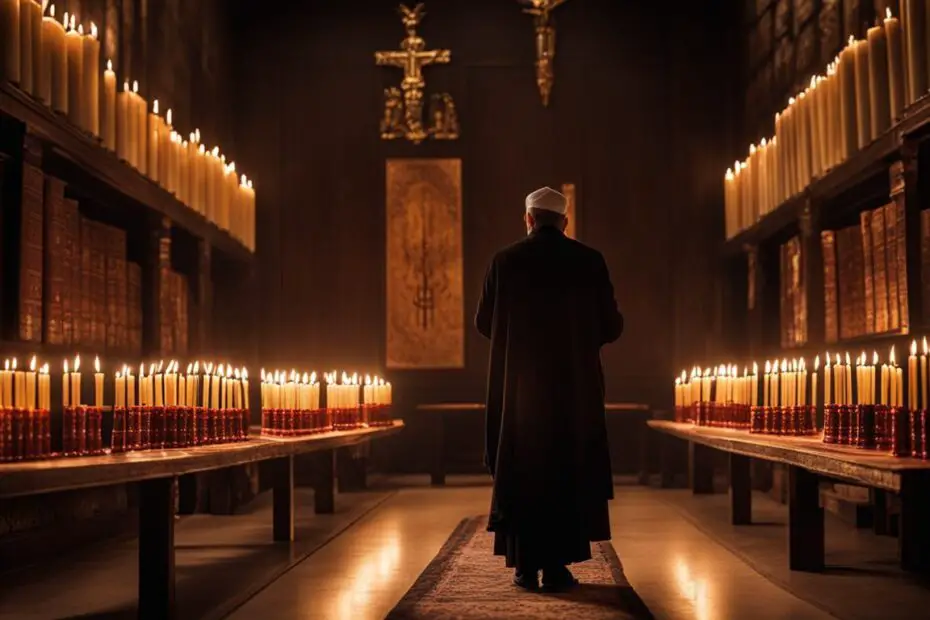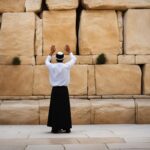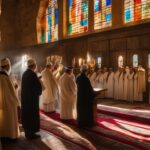Welcome to our in-depth exploration of the prayer practices of Judaism. In this article, we delve into the rich traditions and customs that define Jewish prayer and highlight the significance of these practices in the Jewish faith. From the recitation of sacred texts to the observance of physical movements, prayer in Judaism serves as a powerful means of connecting with the divine and fostering a deep spiritual connection.
Key Takeaways:
- The Shema Yisrael is a central affirmation in Judaism, expressing belief in the singularity of God and dating back to the first millennium B.C.E.
- The Shema prayer emphasizes the unity and love for God, promoting universal monotheism.
- Jewish prayer involves physical movements such as swaying and bowing, symbolizing reverence and focused intention.
- The Amidah prayer, also known as the Standing Prayer, incorporates choreographed gestures to express respect and reverence toward God.
- Prayer in Judaism is a personal and communal act, serving as a means of spiritual connection and communication.
Join us as we delve deeper into these prayer practices and gain a deeper understanding of the profound spiritual significance they hold in Judaism.
The Significance of the Shema Prayer in Judaism
The Shema prayer holds a profound significance in Judaism, representing a powerful declaration of love and devotion to God. It serves as a unifying force, emphasizing the unity and oneness of God in Jewish worship practices. The prayer is recited as part of the morning and evening services, as well as on the holiest day of the Jewish year, Yom Kippur.
At its core, the Shema prayer embodies the belief in monotheism and the commandment to love God with all one’s heart, soul, and strength. It is a poignant expression of faith, reminding Jewish worshipers of their spiritual connection and obligations to God.
Furthermore, the Shema prayer carries historical and cultural significance. Throughout history, it has been recited as a final act of faith by Jewish martyrs, demonstrating their unwavering commitment to their beliefs even in the face of persecution.
The Shema prayer is a testament to the central role of prayer in Judaism and its ability to bring individuals closer to the divine. It is an integral part of Jewish worship practices, promoting a deep sense of spirituality and fostering a connection with God.
Understanding the Verses of the Shema Prayer
The Shema prayer, a central affirmation of Judaism, consists of three passages taken from the Hebrew Bible. Each verse holds significant meaning and provides guidance for Jewish prayer traditions.
Verse 1: “Hear, O Israel! The Lord is our God, the Lord is one”
This opening verse serves as an affirmation of monotheism, declaring that there is only one God. It emphasizes the belief in the singularity, power, and unity of God. It has also been interpreted to promote universal monotheism, reminding Jews of their responsibility to uphold and spread this belief.
Verse 2: “You shall love the Lord your God with all your heart and with all your soul and with all your might”
The second verse of the Shema prayer emphasizes the commandment to love God wholeheartedly. Jews are called to devote their entire being to God, expressing their love, devotion, and dedication. This verse serves as a reminder of the importance of a deep and intimate connection with the divine.
Verse 3: “And these words that I command you today shall be on your heart… Bind them as a sign on your hand and they shall be as frontlets between your eyes… Write them on the doorposts of your house and on your gates”
The third verse highlights the obligation to teach these words to future generations and to keep them at the forefront of daily life. It encourages Jews to constantly remember and internalize the teachings of the Shema prayer, integrating them into their thoughts, actions, and surroundings. The physical act of binding them on one’s hand and forehead and inscribing them on doorposts symbolizes the importance of living a life devoted to God’s commandments.
| Verse | Description |
|---|---|
| 1 | Affirmation of monotheism and promotion of universal monotheism |
| 2 | Commandment to love God with all one’s heart, soul, and might |
| 3 | Obligation to teach and incorporate these words into daily life |
The verses of the Shema prayer encompass the fundamental beliefs and values of Judaism, emphasizing the oneness of God, the commandment to love and devote oneself to God, and the importance of passing down these teachings to future generations. They guide Jewish prayer traditions and serve as a constant reminder of the relationship between the Jewish people and their faith.

The Practice of Swaying (Shuckling) in Jewish Prayer
One distinctive aspect of Jewish prayer customs is the practice of swaying, also known as shuckling. This physical movement involves gentle back and forth motions during prayer, often performed while standing. Swaying is a way for worshipers to put themselves “in the moment” and enhance their focus and intention during prayer.
The act of swaying serves multiple purposes in Jewish prayer. First, it helps individuals align with the rhythm and flow of the liturgy, allowing them to fully immerse themselves in the prayer experience. Additionally, swaying is seen as a way to engage both the body and the mind in worship, connecting the physical and spiritual aspects of prayer.
While the exact origins of swaying in Jewish prayer are not clear, it has become a widespread custom among many Jewish communities. The practice is often associated with fervent devotion and a deep connection to the divine. Whether it is a subtle movement or a more pronounced swaying motion, the act of shuckling adds a unique dimension to the prayer experience for many Jewish worshipers.
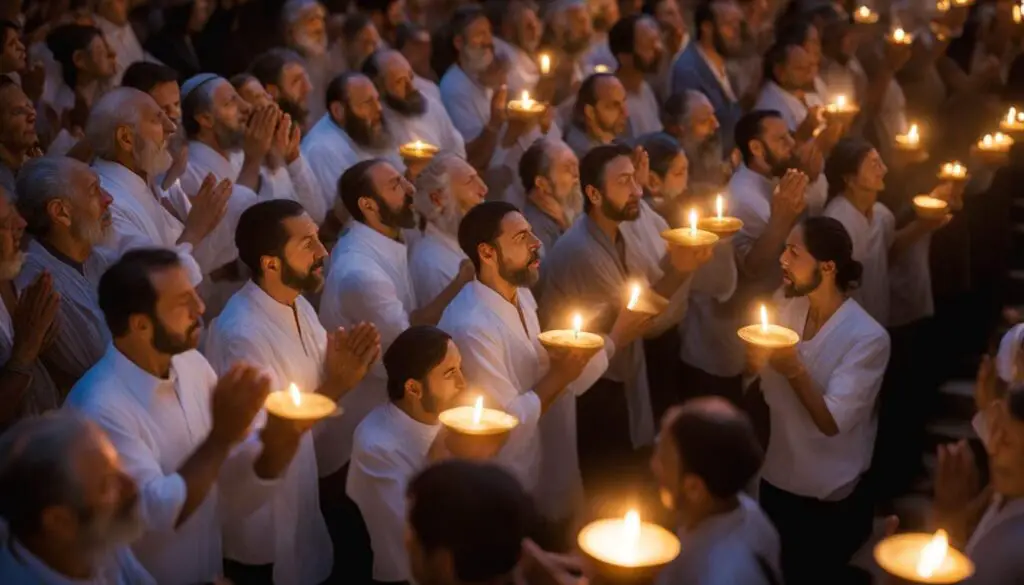
Jewish Prayer Rituals: Standing and Bowing in Prayer
In the practice of Jewish prayer, physical movements and gestures play a significant role in expressing reverence and deepening spiritual connection. Standing and bowing are common rituals that hold symbolic meaning and enhance the prayer experience. These movements are observed during specific prayers and rituals, reinforcing the importance of physical engagement in worship.
During weekday prayers, standing is required for various significant moments, such as reciting the Shema, the Amidah, the Kedushah, and the Hallel. By standing upright, worshippers demonstrate their readiness to listen, receive, and communicate with God. It symbolizes an attentive and respectful posture, acknowledging God’s presence and authority. Standing also represents the equality of all individuals in the presence of the divine, emphasizing the unity of the Jewish community.
Bowing is another physical gesture that occurs during Jewish prayer, particularly in the Amidah. Worshippers bend from the waist at specific points, demonstrating humility, submission, and awe in the presence of God. This act of bowing signifies the recognition of God’s sovereignty and the reverence with which the Jewish people approach their Creator. It is a profound expression of devotion and surrender, reinforcing the vertical relationship between humanity and the divine.
Through these rituals of standing and bowing, prayer in Judaism extends beyond words alone, encompassing the entirety of the individual’s being. The harmonious integration of physical and spiritual elements exemplifies the holistic nature of Jewish worship and the deep connection between mind, body, and soul in the pursuit of spiritual connection.

Table: Standing and Bowing in Jewish Prayer
| Prayer or Ritual | Standing | Bowing |
|---|---|---|
| The Shema | Required | Not required |
| The Amidah | Required | Multiple times, including beginning and end |
| The Kedushah | Required | Not required |
| The recitation of Hallel | Required | Not required |
The Choreography of the Amidah Prayer
The Amidah, also known as the Standing Prayer, is a central prayer in Jewish liturgy. It is a profound moment of connection between worshipers and God, encompassing both language and body language. The Amidah is a choreographed prayer, incorporating various movements and gestures that hold deep symbolic significance.
During the Amidah, worshipers engage in specific physical actions that align with the words and intentions expressed in the prayer. These gestures serve as a way to express respect, reverence, and surrender to God’s sovereignty. The choreography of the Amidah includes bowing from the waist at specific points, such as the beginning and end of the opening and penultimate blessings.
Through these physical movements, worshipers symbolically approach God, acknowledging His majesty and their own humility. The choreography of the Amidah allows worshipers to engage not only their minds and hearts but also their bodies in the act of prayer. It serves as a powerful reminder of the holistic nature of prayer in Judaism, encompassing both the physical and spiritual dimensions of worship.
“The choreography of the Amidah reflects the relationship between the worshiper and God. It is a dance of surrender and devotion, as we bow before the King of the universe.”
The Choreography of the Amidah
The following table summarizes the key movements and gestures in the Amidah prayer:
| Gestures | Symbolic Significance |
|---|---|
| Bowing from the waist | Expressing humility and surrender to God’s sovereignty |
| Opening and closing steps | Marking the beginning and end of the prayer |
| Gently rocking back and forth | Finding rhythm and focus in prayer |
| Standing still | Signifying a moment of connection and communion with God |
The choreography of the Amidah adds a layer of physicality to the act of prayer, enabling worshipers to express their devotion and reverence in a tangible way. It serves as a visual reminder of the deep relationship between the worshiper and God, and the unique bond that is formed through prayer.
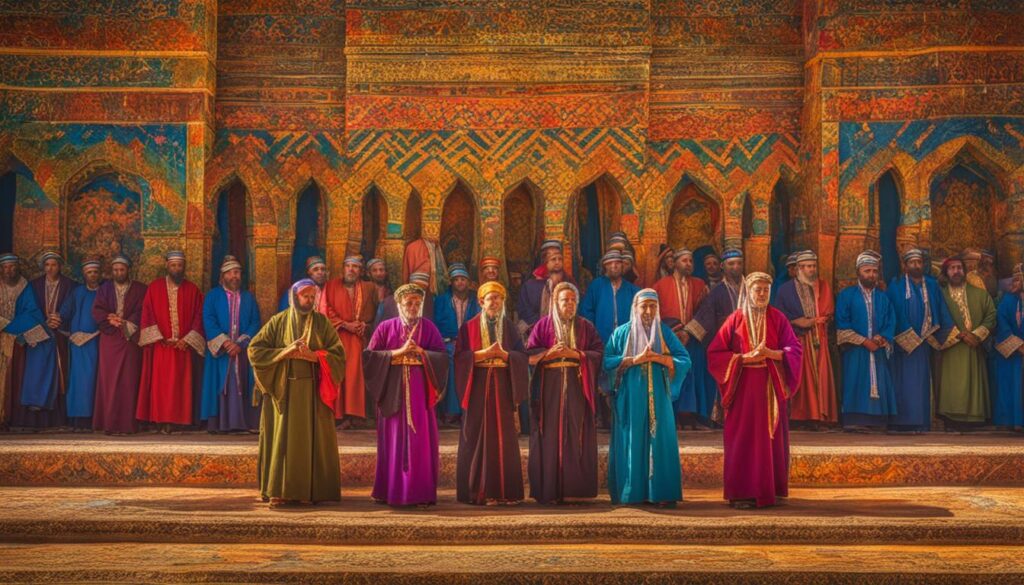
As worshipers engage in the choreography of the Amidah, they enter into a sacred dance, where their bodies become vessels for prayer, and their movements become an expression of their faith. Through this choreography, the Amidah prayer comes alive, inviting worshipers to immerse themselves fully in the experience of connecting with the divine.
Conclusion
Prayer practices in Judaism encompass a deep commitment to worshiping God and establishing a connection with the divine. The Shema prayer holds significant importance, emphasizing the oneness of God and the command to love God with all one’s heart, soul, and strength. Swaying, standing, and bowing during prayer are physical expressions of reverence and focused intention. The choreography of the Amidah prayer highlights the relationship between the worshiper and God as a sovereign being. Overall, prayer in Judaism encompasses both language and body language, serving as a means of spiritual connection and communication.
Throughout the centuries, Jewish prayer traditions have evolved, shaped by textual sources and the customs of Jewish communities. Prayer is seen as a means of communication with God, expressing love, gratitude, and seeking guidance. Synagogue prayers, siddur prayers, and the liturgical calendar all play important roles in maintaining and transmitting these traditions.
Prayer is a fundamental aspect of Jewish religious and spiritual life, reflecting the deep faith and devotion of the Jewish people. It is a personal and communal act that allows individuals to connect with the divine, express their beliefs, and seek spiritual guidance. Through prayer, Jews affirm their commitment to monotheism, express their love for God, and strengthen their relationship with the divine presence.
In conclusion, prayer practices in Judaism are rich and diverse, combining language, physical movements, and gestures. They reflect a deep commitment to faith and spiritual connection, emphasizing the oneness of God, love for God, and reverence for the divine. Prayer in Judaism serves as a way for individuals and communities to express their devotion, seek guidance, and find solace in their relationship with God.
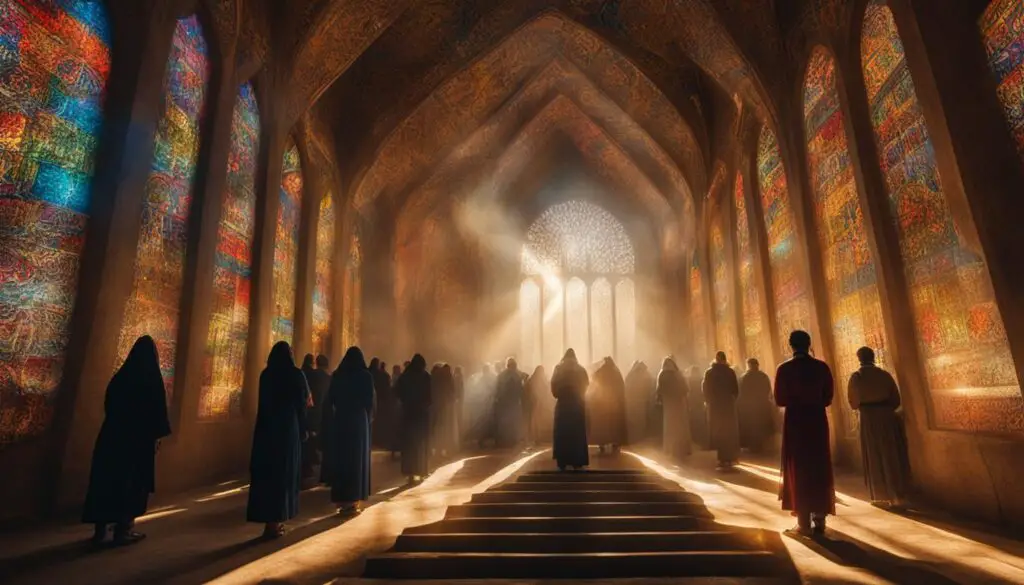
Prayer Practices of Judaism: A Tapestry of Customs and Rituals
Prayer holds great significance in the religious life of Judaism, embodying the deep faith and devotion of the Jewish people. It encompasses a rich tapestry of customs and rituals that enhance the experience of connecting with the divine. From the recitation of specific prayers to the observance of physical movements and gestures, prayer in Judaism is a holistic practice that engages the senses and nurtures the spirit.
Judaism prayer rituals vary across different contexts, from private devotions at home to communal gatherings in synagogues. The use of prayer books, known as siddur, provides a structured framework for worship, guiding individuals through the intricacies of the liturgy. These prayer books contain a compilation of prayers, blessings, and psalms, exemplifying the depth and diversity of Jewish prayers.
“Prayer is not asking. It is a longing of the soul. It is daily admission of one’s weakness. It is better in prayer to have a heart without words than words without a heart.” – Rabbi Abraham Joshua Heschel
Jewish prayer customs and practices reflect a deep reverence for God and a desire to establish a profound connection. This connection is fostered through physical movements such as swaying (shuckling), standing, and bowing. Swaying, a gentle back and forth motion, is a way to immerse oneself in the present moment and cultivate focused intention. Standing and bowing during prayer symbolize humility and respect, embodying the worshiper’s readiness to submit to the divine presence.
To truly appreciate the beauty of Jewish prayer practices, it is necessary to delve into the vibrant traditions and liturgical customs that have been passed down through the generations. These practices not only enrich the spiritual lives of individuals but also contribute to the collective identity and shared experiences of the Jewish community.
The Table below presents some examples of Jewish prayer practices:
| Prayer Practice | Description |
|---|---|
| Shema Yisrael | A central affirmation of Judaism recited twice a day, emphasizing belief in the singularity of God and promoting universal monotheism. |
| Swaying (Shuckling) | Gentle back and forth movements during prayer to enhance focus and align with the rhythm of the liturgy. |
| Standing and Bowing | Physical gestures of reverence and respect, required during specific prayers and rituals, including the Shema, Amidah, and Kedushah. |
| Choreography of the Amidah | The Amidah prayer incorporates choreographed movements, such as bowing at specific moments, symbolizing the approach to God as a sovereign being. |
Jewish Prayer Traditions: A Reflection of Faith and Communication with the Divine
Jewish prayer traditions have been shaped over centuries by the textual sources and customs of Jewish communities, serving as a means of communication with God. These traditions encompass a wide range of practices, expressions of love, gratitude, seeking guidance, and spiritual connection. The synagogue, the siddur (prayer book), and the liturgical calendar all play important roles in maintaining and transmitting these cherished traditions.
“Prayer is not asking. It is a longing of the soul. It is daily admission of one’s weakness.” – Mahatma Gandhi
Judaism places great emphasis on prayer as a personal and communal act of devotion and faith. Through prayer, individuals express their love for God and seek a deeper connection with the divine. It is a practice that transcends time and space, providing a sense of unity and purpose within the Jewish community.
| Jewish Prayer Traditions | Key Aspects |
|---|---|
| Textual Sources | Prayers are rooted in Hebrew Bible verses, such as the Shema and the Amidah, which encapsulate core Jewish beliefs and values. |
| Synagogue Worship | Prayer services are held in synagogues, where individuals gather to pray, study, and connect with their community. |
| Siddur (Prayer Book) | The siddur is a central guidebook containing prayers, blessings, and rituals. It serves as a tool for individuals to navigate the rich tapestry of Jewish prayer traditions. |
| Seasonal Observances | The Jewish liturgical calendar marks significant events and holidays, guiding the prayers and rituals observed during these sacred times. |
Jewish prayer traditions continue to evolve and adapt, reflecting the diverse expressions of faith within the Jewish community. Through these practices, individuals find solace, strength, and a deeper connection with the divine, fostering a sense of spirituality and communal unity.
References:
- Neusner, Jacob. Invitation to the Talmud: A Teaching Book. Wipf and Stock Publishers, 2013.
- Rapoport-Albert, Ada. Prayer in the Talmud: Forms and Patterns. Mohr Siebeck, 1986.
- Gurock, Jeffrey S. Orthodox Judaism in America: A Biographical Dictionary and Sourcebook. Greenwood Publishing Group, 1996.
Prayer in Judaism: Connecting with the Divine
Prayer is a fundamental aspect of Jewish religious and spiritual life. It serves as a powerful means of connecting with the divine, expressing faith, and seeking guidance and support. In Judaism, prayer encompasses a rich tapestry of practices and traditions that reflect the deep devotion and commitment of the Jewish people.
Reciting specific prayers is a central component of Jewish prayer. These prayers, found in the siddur (prayer book), are recited with intention and reverence, allowing individuals to express their love, gratitude, and desires to God. The act of prayer in Judaism is both personal and communal, creating a sense of unity and shared faith among the worshipers.
Physical movements and gestures are also integral to prayer in Judaism. Swaying, standing, and bowing during prayer are not merely symbolic acts, but rather ways of attaining a deeper level of focus and connection with the divine. These physical expressions are rooted in a sense of reverence and respect towards God, enhancing the overall spiritual experience of prayer.
Through prayer, the Jewish people seek to establish a connection with God, to express their beliefs and desires, and to find solace and guidance. It is a practice that embodies the core values and beliefs of Judaism, serving as a vital and meaningful part of Jewish religious and spiritual life.
FAQ
What is the Shema prayer?
The Shema prayer is a central affirmation of Judaism, expressing belief in the singularity of God. It is recited twice a day and serves as the climax of the liturgy on Yom Kippur.
How old is the Shema prayer?
The prayer dates back to the first millennium B.C.E.
What are the verses of the Shema prayer?
The Shema prayer consists of three separate passages from the Hebrew Bible.
What is swaying in Jewish prayer?
Swaying, also known as shuckling, is a characteristic movement during Jewish prayer. It involves gentle back and forth movements and is a physical way of putting oneself “in the moment” and attaining a greater level of focused intention during prayer.
What physical gestures are common in Jewish prayer?
Jewish prayer often involves standing and bowing at certain moments. During weekday prayers, standing is required for specific prayers and rituals, such as the Shema, the Amidah, the Kedushah, and the recitation of Hallel. Bowing from the waist is also common at various points, particularly during the Amidah.
What is the Amidah prayer?
The Amidah, also known as the Standing Prayer, is a central prayer in Jewish liturgy. It incorporates various choreographed movements and gestures. Worshipers bow from the waist at specific points, including the beginning and end of the opening and penultimate blessings.
Source Links
- https://www.exploringjudaism.org/every-day/prayer/understanding-prayer/enhancing-prayer-with-body-movement/
- https://www.brandeis.edu/jewish-experience/holidays-religious-traditions/2022/may/shema-explained-kimelman.html
- https://www.judaismandscience.com/exploring-prayer-a-conversation-with-alden-solovy/


